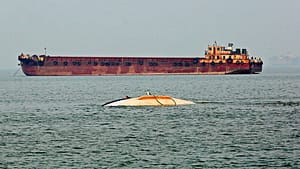As Mumbai’s salt pans face urbanization pressure, experts warn of increased flood risks and ecological damage. Can the city balance growth with environmental protection?
The ongoing controversy over Mumbai’s salt pans stems from the competing interests of environmental conservation and urban development. As Mumbai continues to grow, these natural expanses, which are vital to the city’s ecological health, are increasingly targeted for construction projects, notably for low-cost housing. This situation raises several critical questions about the long-term consequences of such development.
Ecological Importance of Salt Pans
Mumbai’s salt pans, primarily located in the eastern suburbs like Mulund and Kanjurmarg, span approximately 5,378 acres, making them one of the largest undeveloped land parcels left in the city. These low-lying areas act as natural buffers, absorbing excess seawater during high tides and heavy rains, thus preventing flooding in nearby residential zones. They work in tandem with Mumbai’s mangrove ecosystems, which are similarly under threat due to urbanization, to safeguard the city from the increasingly intense and erratic monsoon seasons.
According to environmentalist Debi Goenka, during the catastrophic floods in July 2005, which saw Mumbai receive 944 mm of rainfall in a single day, the salt pans were instrumental in preventing further devastation in the city’s eastern regions. This function is crucial given that climate change is expected to increase the frequency and severity of flooding events. However, the government’s push for slum rehabilitation and low-cost housing on these lands jeopardizes this natural flood defense.
The Conflict Between Development and Sustainability
The most recent flashpoint in this controversy is the transfer of 256 acres of salt pan land to the Dharavi Redevelopment Project Pvt. Ltd. (DRPPL) for housing slum-dwellers, a decision met with heavy criticism from opposition leaders and environmentalists. Shiv Sena leader Aaditya Thackeray accused the Maharashtra government of selling out the city’s natural resources to benefit private developers, notably Adani Realty, one of the key players in the redevelopment project. Critics argue that this is part of a broader pattern of prioritizing short-term economic gains over long-term environmental stability.
In total, about 1,672 acres of Mumbai’s salt pans have been classified as “developable” according to a state government study, with many being eyed for affordable housing. These development projects are presented as a solution to Mumbai’s severe housing shortage. However, environmentalists like Stalin D, director of NGO Vanashakti, have raised concerns that building on these lands would worsen flooding in already vulnerable areas, such as Vikhroli and Bhandup. The ecological damage would not only increase the risk of floods but also disrupt local biodiversity, including bird and insect species that thrive in these salt pans.
Government Policies and Contradictions
There is an inherent contradiction in the government’s stance on Mumbai’s climate resilience. On the one hand, the city’s Mumbai Climate Action Plan acknowledges the growing risks posed by climate change, including flooding and rising sea levels. On the other hand, the government has pursued development projects that threaten the very ecosystems that mitigate these risks.
This dissonance reflects a broader struggle within urban planning: how to balance the demand for housing in one of the world’s most densely populated cities with the need to protect its fragile environment.
In addition to flood prevention, the salt pans also play a socio-economic role, providing livelihoods for thousands of migrant workers involved in salt extraction. Over time, this has decreased as development encroached on the pans, but many still depend on these lands for their livelihoods.
Challenges with Housing Projects
Another challenge is the feasibility of constructing affordable housing on salt pan lands. Experts point out that these areas require extensive land filling, corrosion control, and waterproofing to make them suitable for habitation. This increases the cost of development, casting doubt on the affordability of such housing projects for Mumbai’s slum dwellers. Environmentalists like Goenka also question the quality of life for residents in these developments, as they would be relocated to flood-prone areas, potentially leading to annual inundations during the monsoon.
Conclusion
The debate over Mumbai’s salt pans is emblematic of the city’s broader struggles with balancing growth and sustainability. While the need for affordable housing is undeniable, the environmental costs of developing these ecologically sensitive areas may prove too high. If salt pans are lost to development, the city’s natural flood defenses could be severely compromised, potentially leading to catastrophic consequences in the future. Thus, policymakers must find a way to address Mumbai’s housing needs without sacrificing its environmental security.
This ongoing controversy underscores the importance of preserving urban ecosystems in the face of relentless urbanization, and the decisions made today will shape the future livability of Mumbai in the context of climate change.
THIS POST IS CREATED WITH INSIGHT REFERENCE FROM (DownToEarth, 99Notes, and several different sources)




















